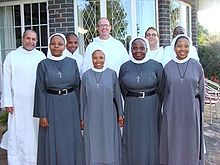Anglican religious order
Amongst the friars and sisters the term mendicant is sometimes applied to orders whose members are geographically mobile, frequently moving between different small community houses.According to ascetical theologian Martin Thornton, much of the appeal is due to Nicholas Ferrar and the Little Gidding community's exemplifying the lack of rigidity (representing the best Anglicanism's via media can offer) and "common-sense simplicity", coupled with "pastoral warmth", which are traceable to the origins of Christianity.[3] Between 1841 and 1855, several religious orders for women were begun, among them the Community of St Mary the Virgin at Wantage and the Society of Saint Margaret at East Grinstead.In North America, the founding of Anglican religious orders began in 1842 with the Nashotah Community for men in Wisconsin, followed in 1845 by the Sisterhood of the Holy Communion under Anne Ayres in New York.In recent decades, religious orders have been remarkably grown in other parts of the Anglican Communion, most notably in Tanzania, South Africa, the Solomon Islands, Vanuatu, and Papua New Guinea.It is grievously in need of them.” Practical efforts were made in the religious households of Nicholas Ferrar at Little Gidding, 1625, and of William Law at King's Cliffe, 1743; and under Charles II, says Fr.Bede[clarification needed] in his Autobiography, “about 12 Protestant ladies of gentle birth and considerable means” founded a short-lived convent, with William Sancroft, then Dean of St Paul's, for director.Southey's appeal had weight, and before the thirty years had passed, compassion for the needs of the destitute in great cities, and the impulse of a strong Church revival, aroused a body of laymen, among whom were included William Gladstone, Sir T. D. Acland, Mr A. J. Beresford-Hope, Lord Lyttelton and Lord John Manners (chairman), to exertions which restored sisterhoods to the Church of England.The Community of St John Baptist at Clewer, near Windsor, arose in 1849 through the efforts of a Mrs Tennant and the vicar, afterwards warden of the society, the Revd T. T. Carter, to save "fallen women".Their services to society and the church include six houses for "fallen women", seven orphanages, nine elementary and high schools and colleges, five hospitals, mission work in 13 parishes and visiting in several “married quarters” of barracks.This charitable activity, however, distinguishes the modern sister from the nuns of primitive and medieval times, who were cloistered and contemplative, and left external works to deaconesses, or to laywomen of a third order, or to the freer societies like the Beguines.The Episcopal Carmel of Saint Teresa in Maryland is a full expression of the Carmelite order and rule within Anglicanism, founded for that purpose with the support of the American House of Bishops.The Order embraces the Rule of St. Augustine, guiding its members towards a life of prayer, community service, and frequent engagement with the sacraments.The 1939 novel Black Narcissus by Rumer Godden is about a group of Anglican Nuns (the Order of the Servants of Mary) who persist in trying to establish a religious community in the Palace of Mopu in the Himalayas, Nepal, despite the sisters feeling sexual repression and enduring forbidden love.
Former religious orders in the Anglican CommunionAnglicanismTheologyChristian theologyAnglican doctrineThirty-nine ArticlesBooks of HomiliesCaroline DivinesChicago–Lambeth QuadrilateralEpiscopal politySacramentsMinistryEucharistKing James VersionBook of Common PrayerLiturgical yearChurchmanshipCentralSaintsJesus PrayerChristianityChristChristian ChurchFirst seven ecumenical councilsCeltic ChristianityAugustine of CanterburyMedieval cathedral architectureApostolic successionHenry VIIIEnglish ReformationThomas CranmerDissolution of the monasteriesChurch of EnglandEdward VIElizabeth IMatthew ParkerRichard HookerJames ICharles IWilliam LaudNonjuring schismLatitudinarianAnglo-CatholicismLiberalOxford MovementAnglican CommunionAnglican Communion historyArchbishop of CanterburyAnglican Communion Primates'MeetingsLambeth ConferenceBishopsAnglican Consultative CouncilEcumenismOrdination of womenWindsor ReportContinuing Anglican movementAnglican realignmentBartonville AgreementCongress of St. LouisNorth American Anglican Conferencereligious orderspovertychastityobedienceclergyKing Henry VIIINicholas FerrarLittle Gidding communityRule of Saint Benedicthigh churchPuritansArminian heresyKing Charles ICavalierBattle of NasebyBishop Francis TurnerLittle Giddingascetical theologianMartin Thorntonvia mediaCommunity of St Mary the VirginWantageSociety of Saint MargaretSociety of St. John the EvangelistNashotah CommunityWisconsinAnne AyresNew YorkTanzaniaSouth AfricaSolomon IslandsVanuatuPapua New GuineaRobert SoutheyBeguinesSisters of mercyWilliam LawKing's CliffeCharles IIWilliam SancroftDean of St Paul'sWilliam GladstoneEdward PuseyCrimean WarFlorence NightingaleSociety of the Holy and Undivided TrinityMarian HughesClewerAll SaintsEast GrinsteadCommunity of St John BaptistT. T. Carterfallen womenHarriet MonsellEpiscopal Church of ScotlandEpiscopal Church of AmericaChurchChurch CongressesLambeth ConferencesSt Vincent de PaulcelibatechaplainChurch House, WestminsterChurch CommissionersGeneral Synod